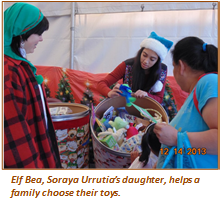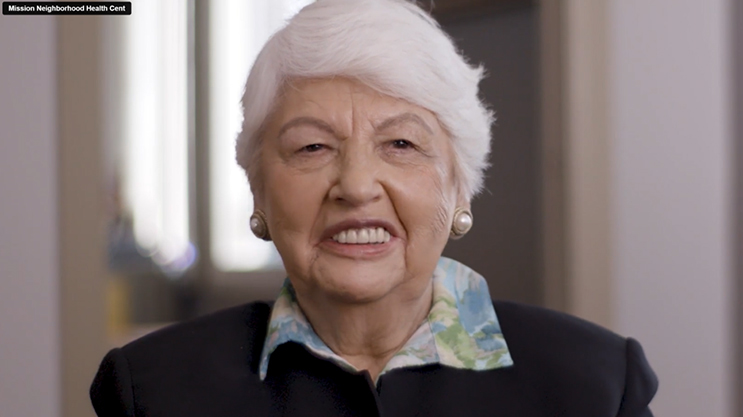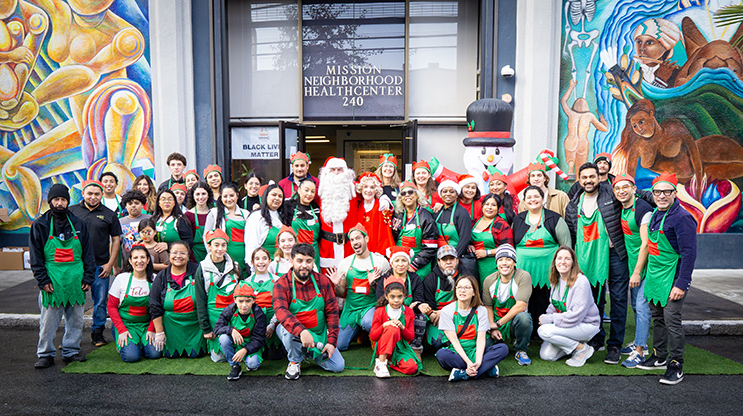December 3, 2014
Fall 2014 Newsletter

A Note from Our Executive Director
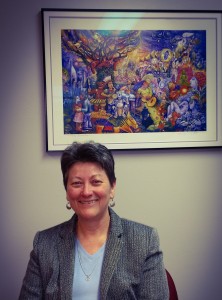
As 2014 sunsets and we look forward to a New Year I want to wish all of you very Happy Holidays and best wishes for a healthy and prosperous New Year! We are so grateful that in this past year, the Affordable Care Act brought to the families and communities we serve increased access to health insurance coverage through Covered California and the expanded Medi-Cal program. The health center also received federal funding that will enable us in the coming year to increase our hours of operation and expand our behavioral health services. I am also encouraged that the immigration changes recently announced by President Obama will positively benefit many of the families we serve and open the doors of hope for the future.
It is in this spirit of giving and receiving that I ask you to support our holiday toy giveaway to brighten a child’s Christmas. Please see below the story of this special volunteer event, as well as our efforts to combat childhood obesity and how through the use of teamwork and strong relationships we make a difference in the lives of our patients with HIV/AIDS.
Happy Holidays!
Help Us Brighten a Child’s Christmas on December 13th
Every December on a Saturday at 5:30 am for the past 36 years a quiet line begins to form around the block at Mission Neighborhood Health Center’s Shotwell site. Sleepy children and their parents secure a spot to partake in the annual Christmas Toy Give Away, which starts at 10:00 am. For many of the children in line, the new toy they will receive that day may be the only “new” one they get for Christmas.
The event, organized by MNHC and led by Soraya Urrutia, operations coordinator, is packed with fun for families beginning with a parade on Shotwell Street between 16th and 17th led by a group of angels and Mr. and Mrs. Claus. The parade arrives at the MNHC parking lot where each child can visit with Santa and his wife in a tent and receive a Polaroid picture of them sitting on their laps.
They can then choose a small toy with the assistance of one of the elves and move onto another tent to pick up a larger age-appropriate toy. Families enjoy hot dogs, fruit, ice cream,popcorn, and face painting all to the music of a DJ who volunteers part of his time. And this year, as in past years, Walgreens staff will provide free flu shots to adults. As families leave they all receive a bag of groceries from the SF Food Bank – healthy items that are aligned with MNHC’s mission to promote health.
 It’s truly a labor of love by all involved and emblematic of MNHC’s ongoing commitment to the fabric of the community. “We start planning the event in July to ensure we will have enough resources and volunteers to be able to serve as many families as possible,” said Soraya.
It’s truly a labor of love by all involved and emblematic of MNHC’s ongoing commitment to the fabric of the community. “We start planning the event in July to ensure we will have enough resources and volunteers to be able to serve as many families as possible,” said Soraya.
For many years, Carol Stone, a Marin resident, was a cornerstone of organizing the event serving as Mrs. Claus. She enlisted the assistance of McKesson as a corporate donor where she worked and worked closely with her church community at St. Patrick’s in Larkspur to recruit volunteer elves and to donate many of the toys. She was so committed to the event that even in her final days of battling cancer she insisted on participating passing away just a couple weeks later. There is even a room dedicated to Carol in the Shotwell site.
Before she passed away, she asked Erin Loftus-Sweetland, a fellow church member, to assume the role of Mrs. Claus. Extending Carol’s legacy since 2002, Erin and her husband Patrick have served in this esteemed role also working closely with their church to support the drive.
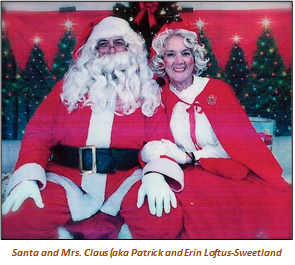 The corporate funding has since receded and the grassroots fundraising consisting of donations from community organizations such as local schools and churches limits how many children we can delight!
The corporate funding has since receded and the grassroots fundraising consisting of donations from community organizations such as local schools and churches limits how many children we can delight!
This year the event will be held on Saturday, December 13th, and we need your help. Even the smallest of donations helps fund more toys so that we can serve more families and children. Won’t you or your organization consider participating this year ensuring that those less fortunate can partake of the joy and fun of the season?
To make a donation by credit card, please call Nora Abaunza at 415-552-1013 X 225 or you may mail a check payable to MNHC and mail to MNHC- Children’s Holiday Party, 240 Shotwell Street,
San Francisco, CA 94110. Donations may also be made through our website at www.mnhc.org
The kids are counting on your help!
Making A Difference: Teamwork that Improves Outcomes
It only takes a few moments to notice the humble pride in the voices of Joanna Eveland, MD, MS, clinical chief for special populations, HIV services and homeless services, and Vidal Antonio, HIV services director, when they speak about their teamwork at MNHC’s Clinica Esperanza (Clinic of Hope). Their commitment to their patients is palpable. It’s a commitment coupled with an integrative, holistic team model of care resulting in impressive clinical indicators that differentiate Clinica Esperanza, which celebrates its 25th anniversary this December, from any other clinic devoted to HIV services in the region if not the nation. As of June 2014, its patient population boasts a high viral suppression rate (88%), well above the average rate in the nation (25%)1. Retention rates are at 94% and 97% of patients are on antiretroviral therapy (ART).
MNHC Clinica Esperanza Clinical Indicators –June 2014

The clinic serves about 400 patients, mostly Latino men, many of whom are monolingual in Spanish. All services are available in Spanish and English. Services include primary medical care, case management, AIDs management, behavioral health, HIV testing, HIV prevention, nutrition services, outreach, peer advocate and support services, health education including smoking cessation programs, insurance enrollment assistance, and social programs such as a mask making workshop and stress reduction knitting group.
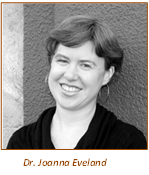 Dr. Eveland, a family medicine physician who joined MNHC in 2010 and specializes in HIV care, received her medical degree from UCSF and completed a residency with Contra Costa County Health Services in which she cared for HIV+ patients in a community based practice.
Dr. Eveland, a family medicine physician who joined MNHC in 2010 and specializes in HIV care, received her medical degree from UCSF and completed a residency with Contra Costa County Health Services in which she cared for HIV+ patients in a community based practice.
One of her primary goals upon arriving was to strengthen the culturally sensitive team-based program that places the patient at the center of care allowing staff to work together to proactively to meet the patients’ needs.
Her goal did not go unnoticed as she recently received the AAHIVM/Institute for Technology in Health Care HIV Practice Award for her innovative use of i2iTracks Population Health Management software (www.i2isys.com) that facilitates linkages, retention and treatment adherence for a high-risk population. The i2i (interface-to-interface) software, that enables the team to keep the patient front and center and was implemented in 2011 at MNHC, integrates data from the electronic health record (EHR), practice management system, laboratory, and manually entered data to populate an easily searchable database that can be accessed by any member of the clinical team.
“The i2i system allows us to work more efficiently as a team. Our commitment to training staff on the use of this technology helps guide interventions and Quality Improvement processes at all levels in our HIV practice,” said Dr. Eveland. “Our clients want to stay virally suppressed and stay in care, but sometimes they need extra help to do so or otherwise they could slip quietly out of care. While we are not the first HIV clinic to use i2i Tracks, our incorporation of this technology into the workflow of every member of our multidisciplinary staff has transformed a strong team into an outstanding team, with clinical outcomes that stand in stark contrast to national data.”
Historically, MNHC conducted annual audits but with the use of the i2i system, they can conduct real time population management. “We are very proactive in engaging patients in their care,” said Vidal, lauding the value of the overall approach and the use of population health technology.

“If we don’t hear from a patient for a while we will send someone to their home or wherever we think they may be, even under a bridge, if necessary, to check on them,” he added. “We want to make sure that no one falls through the cracks, that everyone adheres to their treatment plan and that we can provide the best quality of life possible for our patients. It’s part of the fabric of our care.”
Equally important as the impressive clinical indicators and integrated system are the close relationships developed through caring for patients. Staff and patients alike echo a feeling of familia. As one patient stated so aptly, “This staff loves us. Now that I have experienced it, I understand the profoundly positive effect it has on my health. Nothing else will do.”
“This place is special,” Vidal explained. “We have a strong commitment to excellence that we strive to achieve and then we are encouraged to do even better. It’s a real motivator, and ultimately, its’ our patients that benefit the most.”
“I love this work,” said Dr. Eveland in her humble self-effacing manner. “It’s fun to see my patients doing so well and gratifying that we can make a real difference in their lives.”
1AIDS.gov/CDC 2012
Collaborative Intervention and Study Coupled with leading Obesity Research with Latino Children Helps MNHC Attack Childhood Obesity
Childhood obesity has more than doubled in children and quadrupled in adolescents in the past 30 years.1, 2 In 2012, MNHC discovered that 47% of its pediatric patients ages
3-19 were obese or overweight – approximately 1800 children. The news was very concerning to staff and fueled a concerted effort to reverse the trend.
One of the interventions consisted of a unique collaboration called “Familias Activas y Sanas” (FAS-Active and Healthy Families) that joined together the resources of MNHC, CARECEN – the Central American Resource Center, and Instituto Familiar de la Raza (IFR) funded by the Community Clinic Initiative-Tides Center. The three organizations determined that a coordinated primary care, behavioral health and community wellness intervention could help reverse the tide of obesity among Latino children in the Mission District. FAS was a multi-prong intervention to reduce the obesity/overweight rate of MNHC’s pediatric patients. MNHC provided medical and nutritional counseling services; CARECEN provided Promotoras to educate parents on healthy cooking and IFR provided psychosocial interventions.
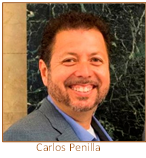 Carlos Penilla, a doctor of public health (DrPH) candidate at UC Berkeley School of Public Health, who served as the program evaluator, developed a series of educational tools for parents and program evaluation measures. His involvement in the project was invaluable as he focuses his research specifically on obesity prevention in Latino children to identify the modifiable risk factors that contribute to childhood obesity. In collaboration with researchers at the University of California San Francisco, Carlos has conducted extensive research using evidence-based information to better understand parental child feeding practices in families with both a mother and father in the home. In a two-year longitudinal study, over 300 Mexican-American families with children ages 8-10 were followed.
Carlos Penilla, a doctor of public health (DrPH) candidate at UC Berkeley School of Public Health, who served as the program evaluator, developed a series of educational tools for parents and program evaluation measures. His involvement in the project was invaluable as he focuses his research specifically on obesity prevention in Latino children to identify the modifiable risk factors that contribute to childhood obesity. In collaboration with researchers at the University of California San Francisco, Carlos has conducted extensive research using evidence-based information to better understand parental child feeding practices in families with both a mother and father in the home. In a two-year longitudinal study, over 300 Mexican-American families with children ages 8-10 were followed.
Surprisingly, the research identified that both parents influence a child’s weight, as measured by their body mass index (BMI), not just the mother’s, contrary to popular belief. Mothers reporting more positive involvement in children’s meals resulted in children with lower BMI percentiles. Parents using more pressure to eat had children with lower BMI percentiles, while parents using more restriction of food resulted in children with higher BMI percentiles, the opposite of the desired outcome. Fathers using food to control behavior had children with lower BMI percentiles. Over the two-year study period, parents also behaved differently based on the child’s gender and weight: overweight girls had a stronger influence on their father’s child-feeding behavior, while overweight boys had a stronger influence on their mother’s child-feeding behavior. Ideally, education messages about an overweight or obese child need to be tailored to both the mothers’ and fathers’ individual child-feeding behavior.
Adherence to the recommended FAS strategies was challenging for many families that face competing priorities (e.g., work, school, transportation) that can interfere with healthy habits and even just following through on referrals and keeping appointments. For many working families in the Mission District childhood overweight and obesity is low on the list of health priorities. Involving both parents in a childhood obesity intervention requires having resources available when and how they need them such as brief education sessions on weekends or in the evening during the week.
The results of this two-year intervention, however, are promising: 2,090 children and 1,395 parents attended educational classes offered by CARECEN Promotoras and 1,114 children received a body-mass index (BMI) test. Additionally, the organizations strengthened their ties through the collaboration to provide more resources to support primary care and an integrated approach to health care in the community. For example, although funding for the study has ceased, CARECEN continues to provide health education classes to parents of pediatric patients.
In 2013, Carlos applied the evidence-based research and incorporated it with the findings from the FAS collaborative to develop a program for implementation at MNHC’s Excelsior site. Although it is in the early stages of implementation, we are already seeing improvements in lowering the obesity rates of our pediatric patient population. Four hundred seventy-one (471) children were identified as being overweight or obese in the study and since participating in the program 16% (75 children) lowered their BMI measures. Using the relative improvement value over baseline methodology (which evaluates performance in a clinical quality improvement project), it represents a relative improvement of 107%.
This year, we submitted our competitive grant to HRSA-Bureau of Primary Health Care and hope that with additional funding to see continued improvements in this population. We are confident that an integrated approach –like the one offered by FAS will improve the health and well being of Latino children.
1 Ogden CL, Carroll MD, Kit BK, Flegal KM. Prevalence of childhood and adult obesity in the United States, 2011-2012. Journal of the American Medical Association 2014;311(8):806-814.
2 National Center for Health Statistics. Health, United States, 2011: With Special Features on Socioeconomic Status and Health. Hyattsville, MD; U.S. Department of Health and Human Services; 2012.
3 Tschann et al. International Journal of Behavioral Nutrition and Physical Activity 2013, 10:6 http://www.ijbnpa.org/content/10/1/6


